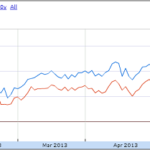Investors have been on the hunt for yield ever since policy pushed investors to risk assets to generate any real return. Yields on US Treasuries, certificates of deposit, and short-term corporate bonds is without question well below the rate of inflation.
Yields are certainly lower than the true rate of inflation as defined by the everyday price index.
Is yield overrated?
Playing the yield game is dangerous. For one, it’s easy to overlook the risk of capital losses when investors’ look at yield only. Secondly, when investors begin to seek yield from two very different asset classes – fixed-income investments vs. equities – rising stock prices follow as investors bid down a yield to match alternatives.
These are the three biggest signs that investors have gone too far in pursuit of yield:
- Utilities are trouncing the S&P 500 – The Utilities SPDR (XLU) fund is one of this years’ hottest performing ETFs, up more than 17% year-to-date compared to SPDR S&P 500’s (SPY) 13% return. The rise of the utility sector is partly due to a late year 2012 sell-off when investors feared the possibility of higher dividend and capital gains taxation in 2013. I wrote then that utility ETFs were a relative value, and that the risks of rising dividend taxes was overblown. Now, with the utility sector rising quickly, utility stocks trade at more than 16 times forward earnings estimates while paying out only 3.55% in yield. Utilities trade at a premium earnings multiple to the broad market but have below-average potential for earnings growth. If investors only want yield, utilities are a good place to find it. But total return has to called into question at the current multiple.
- Junk bond rates hit record low – Companies which source funding from the junk bond market are currently borrowing at the lowest rates in history. Barron’s has actively tracked this trend, posting near-daily updates about the ever-plunging costs of debt financing for companies with weak balance sheets. The retail investors’ access to the market for junk-rated debt securities improved dramatically after the launch of several successful junk bond funds. These index funds are partially responsible for a surge in junk bond values. The average junk bond now trades at 5 cents over par value. SPDR Barclays Capital High Yield Bond ETF (JNK) is up 4.5% in total return since the beginning of 2013. Junk bonds provide evidence for extreme yield chasing. In an earlier article, I wrote of an actively-managed junk bond ETF that was beating the benchmarks because it could find more attractively-priced bonds that aren’t in junk bond ETF indexes.
- Investors are becoming more active – Fund flows show that investors are starting to get more aggressive about how they allocate money to new funds. The largest 100 ETFs have a smaller share of fund assets than last year, 77% vs 82% while the largest 50 have 62% compared to 69% of all assets in 2012. Forty-two percent of funds are flowing into funds that are not market-cap weighted, according to data from BlackRock, which indicates a shift in how people are taking to the markets. New investment styles are certainly driving the trend as investors begin to invest more time into smaller, niche ETFs. There’s an ETF for everything – from a recently-hot hedged Japanese equities fund to dividend and junk bond ETFs that lapped up inflows in 2012.
When high yields aren’t high
When risk-free and AAA-rated corporate bonds yield less than 4%, 3.5% yield on utilities and 6% yields from junk ETFs are difficult to pass up. (For historical reference, yields in the high-yield space were in the double-digits in 2010). The risks of capital losses fall out of the decision-making process. Dividend growth investing has become a new “trendy” thing in the world of retail finance. Investors buy the yield, and assume they’ll simply hold forever, thus removing the consequences of capital losses. Rarely does the retail investor stick the game plan, however.
Historical data obscures the effects of the great recession. 3-year data is all positive. Next year, 2008 declines will fall out of 5-year data, painting an even rosier picture for investment returns.
This yield trade, much like the trade in gold and silver, has to reverse at some point. When it does, we’ll really see just how willing investors are to hold a capital loss greater than several years of dividend payments. My guess is that investors aren’t as patient as they might claim.
Disclosure: No positions in any tickers mentioned here.











{ 0 comments… add one now }